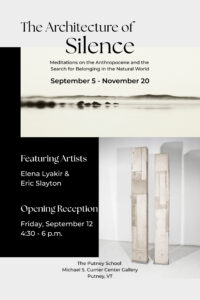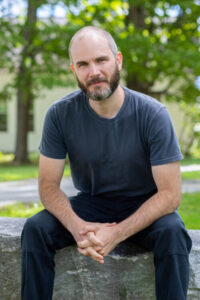Archives
Flying Colors
50 Years 5 Questions
The Theory of Loose Parts
The Promise of a Chance to Work, to Live
Soldiers on Skis: The Story of 14 Putney Alumni During WWII
Putney to Celebrate Harvest Festival on October 12
 On Sunday, October 12, The Putney School will come together with food, music, crafts, games and good cheer for Harvest Festival, our annual fall celebration. Activities will take place from 10 a.m. — 3:30 p.m., rain or shine, and include a bounce house, face painting, vendors, games and more.
On Sunday, October 12, The Putney School will come together with food, music, crafts, games and good cheer for Harvest Festival, our annual fall celebration. Activities will take place from 10 a.m. — 3:30 p.m., rain or shine, and include a bounce house, face painting, vendors, games and more.
Harvest Festival is a tradition that dates back to the school’s founding in 1935.
Art Exhibit: The Architecture of Silence, Sep. 5 — Nov. 20
Opening Reception Friday, Sep. 12, 4:30 — 6 p.m.
 The Michael S. Currier Center Gallery at The Putney School will present “The Architecture of Silence: Meditations on the Anthropocene and the Search for Belonging in the Natural World.” The exhibit runs from September 5 — November 20, with an Opening Reception on Friday, September 12, from 4:30 — 6 p.m.
The Michael S. Currier Center Gallery at The Putney School will present “The Architecture of Silence: Meditations on the Anthropocene and the Search for Belonging in the Natural World.” The exhibit runs from September 5 — November 20, with an Opening Reception on Friday, September 12, from 4:30 — 6 p.m.
The exhibit features artists Eric Slayton and Elena Lyakir, who explore the intersection of place and belonging, creating a dialogue between the inner and the outer. Elena, born in Ukraine, creates layered landscapes and photographs of birds in flight, which seek to unravel the trauma of dislocation she experienced as an immigrant, restoring a sense of wholeness and continuity aligned with the natural world. Eric’s brutalist architectural structures evoke the urban horizons that nature eventually reclaims, as he believes that nature is the ever-present principle. His work is a meditation on resilience, time, and transformation. World travelers and longtime city dwellers, Eric and Elena now live and work in Marlboro, Vt.
Eric Slayton Artist Statement:
Eric’s attraction to a pallet of industrial materials, combined with the Japanese practice of process with intention, articulates an organic modernist and even brutalist approach in the formation of his works. From conception to actualization, and then the eventual patina, the story reads as “nature into art toward time.”
He celebrates the beauty of imperfection and incorporates the time-marinating created during the aging process. Unrefined surfaces contained within percipient proportions, merged with an understanding of bio-centric processes, accurately describe his path and practice.
The symbolism of these monoliths is as conspicuous as is the simplicity in form. The applied principles are gingerly gleaned from the iconic shapes of contemporary architecture that proliferate urban horizons of this geologic epoch now labeled as the Anthropocean.
Scale and proportions are crucial to the integrity and esthetic, yet the walls of each side provide the canvas where the piece’s story unfolds. Even the top, which may be too high to see, is an underutilized opportunity.
For Eric, the “beauty” in his works comes from the belief that in the end nature is the ever-present principle. Confirmed in that all efforts are conceived of knowing that those reclamation forces of time are guaranteed.
Elena Lyakir Artist Statement:
As an immigrant, I am perpetually searching for a place that feels like home, and my creative expression stems from this longing. Although my work is not a direct commentary on my experiences as a refugee, it serves as a metaphor for emotions that crystallize within when we search for our place in the world. The ethereal, poetically layered landscapes and bird photographs I create symbolize the complexities that shape and color our perception of reality, as we all perceive the world through a unique and individual lens.
Through my work I explore themes of memory, perception, belonging, and nostalgia, gently unraveling the trauma of displacement. Layer by layer, I seek to rebuild the fragmented soul by filling in the gaps left by upheaval and disruption, restoring a sense of wholeness and continuity aligned with the natural world. I attempt to ignite a dialogue between internal and external landscapes, transcending the boundaries of reality and imagination. My work is a meditation on the poignant duality of beauty intertwined with a sense of nostalgia, which the dislocated, like myself, are destined to inhabit.
My practice is often informed by site-specific work. The preparation for a new project involves immersing myself in a landscape, spending many hours listening, contemplating, and investigating. To capture the dreamlike landscapes, I employ a range of techniques, including tilt shift lenses, makeshift filters, and in-camera multi-exposures. The intuitive nature of my creative process is a means of transcendence, healing, and revelation of the extraordinary.
Putney Featured in Town & Country Magazine
Putney is featured in the most recent issue of Town & Country magazine, in an article about the future of progressive education.
The article, “Can Private ‘Alternative’ Schools Survive in the Age of Cutthroat College Admission?” features comments from Reid Hoffman ’85, co-founder of LinkedIn. He credits Putney with inspiring his first book, The Start-Up of You: Adapt, Take Risks, Grow Your Network, and Transform Your Career.
“Some of the central lessons of the book, many of which I learned at Putney, include being a lifelong learner and constantly adapting to your surroundings,” he said.
History Teacher Pat O’Connor Publishes Book About American Tobacco Industry
 Written by History Teacher and History Department Chair Pat O’Connor, his newly published book, The Political Reconstruction of American Tobacco, 1862-1933, explores how the federal government influenced the tobacco industry following the Civil War.
Written by History Teacher and History Department Chair Pat O’Connor, his newly published book, The Political Reconstruction of American Tobacco, 1862-1933, explores how the federal government influenced the tobacco industry following the Civil War.
“It explains how the tobacco industry — a pillar of American political economy since the early colonial period — was utterly transformed in the decades after the Civil War,” O’Connor said. “Broadly speaking, I am interested in how law and politics shape markets and the costs for those who lack the political power to participate in that process.”

The “deeply researched and clearly argued account,” digs into everything from labor to consumption; manufacturing to regulation, and demonstrates how tobacco emerged as a new industry that created immense power and stifling poverty across the nation, according to the description.
As a teacher, O’Connor often stresses to his students that they themselves are historians.
“They should know how to generate analytical questions about any information they encounter,” he said. “They should know how to find sources that can help them learn how to answer their questions, and then they need to know how to read and interpret those sources and put them into context to understand why they’re important. That’s what historians do professionally, and that’s what our classrooms are intended to help students learn.”
Throughout his book, there’s no question that O’Connor puts his teaching philosophy into practice.
“My book shows that the American tobacco market changed so much after the Civil War because of politics: manufacturers formed trade associations to shape federal tax policy (and ended up playing a crucial role in the construction of the Bureau of Internal Revenue —now known as the Internal Revenue Service); fertilizer producers and warehouse operators coordinated their efforts to determine international definitions of tobacco’s quality; and crop scientists promoted US tobacco production,” he said. “The tobacco market these people created overlooked, and even dismissed, the interests of tobacco growers, especially newly emancipated Black farmers and impoverished white farmers throughout the South. Like many markets, the tobacco market came to seem natural, but it was not. It was a political creation that rationalized debt, poverty, and intensified labor for thousands of small farmers.”
The Political Reconstruction of American Tobacco, 1862-1933 was published by Fordham University Press. A copy is available at the Putney library.

